Baseball is a sport that is so popular in the United States that it is often called the national pastime. Every spring and summer, millions of people throughout the country play this exciting “bat and ball” game. Millions also watch baseball games and closely follow the progress of their favorite teams and players. 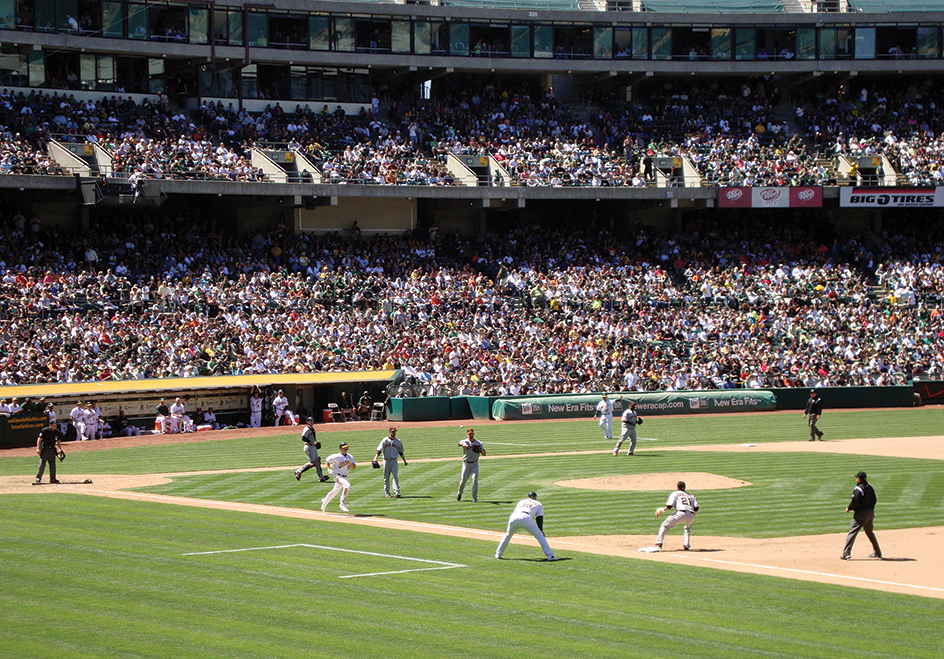
There are organized baseball teams for every age group from 4-year-olds to adults. The teams that attract the most interest are those of the two major leagues: the American League and the National League. These teams are made up of men who rank as the world’s best players. Every year, tens of millions of people flock to ballparks to watch major league baseball games. Many more millions watch games on television, listen to them on radio, read about them in newspapers, and discuss them with their friends.
Baseball began in the eastern United States in the mid-1800’s. By the late 1800’s, people throughout the country were playing the game. The National League was founded in 1876, and the American League in 1900. Through the years, baseball spread from the United States to other parts of the world. Today, it ranks as a major sport in such countries as Canada, Italy, Japan, Taiwan, the Netherlands, South Africa, and many Latin American nations.
How the game is played
A baseball game is played on a large field between two teams of 9 or 10 players each. The teams take turns at bat (on offense) and in the field (on defense). A player of the team in the field, called the pitcher, throws a baseball toward a player of the team at bat, called the batter. The batter tries to hit the ball with a bat and drive it out of the reach of the players in the field. By hitting the ball, and in other ways, players can advance around the four bases that lie on the field. A player who does so scores a run. The team that scores the most runs wins the game.
The information in this section is based on the rules of major league baseball. Most other leagues follow much the same rules. The section on Baseball leagues later in this article lists some exceptions. For information on softball, a popular game based on baseball, see Softball.
Players and equipment
Players.
Baseball teams include at least nine players: a pitcher, catcher, first baseman, second baseman, shortstop, third baseman, left fielder, center fielder, and right fielder. Except for most pitchers, each player plays a defensive position when his team is in the field and takes a turn as the batter when his team is at bat.

Teams may—and almost always do—use a tenth player. This player, called the designated hitter (DH), bats in place of the pitcher. The DH does not play a defensive position. The American League adopted the designated hitter rule in 1973. The National League adopted it in 2022.
Baseball teams also have substitute players. A substitute may replace any player except the pitcher at any time. A pitcher must face at least one batter before leaving the game. A player who leaves a game for a substitute may not return to the game.
Other members of a baseball team include a manager and several coaches. The manager decides which players will play in the game and directs the team’s strategy. The coaches assist the manager.
Equipment.
A baseball is a small, hard, round ball. It measures from 9 to 9 1/4 inches (23 to 23.5 centimeters) in circumference and weighs between 5 and 5 1/4 ounces (142 and 148.8 grams). A tiny cork ball forms the center of the ball. Tightly wrapped layers of rubber and yarn surround the cork. Two strips of white cowhide sewn together with thick red thread cover the ball. Until 1974, the cover was made of horsehide, rather than cowhide. For this reason, baseballs are sometimes called horsehides.
A baseball bat is a long, rounded piece of wood. A major league baseball bat may not measure more than 42 inches (107 centimeters) long or 2 3/4 inches (7 centimeters) in diameter at its thickest point.
Each defensive player wears a padded leather glove, and uses it to catch the ball. There are three kinds of gloves: the catcher’s mitt, which is worn by the catcher; the first baseman’s glove, which is worn by the first baseman; and the fielder’s glove, which is worn by all other players.
All players wear shoes with spikes on the soles so they can stop and start quickly. Most players wear shoes with metal spikes. But some wear shoes with synthetic rubber spikes when they play on fields covered by artificial turf. Players also wear uniforms, which include socks, knickers, a jersey, and a cap. The batter wears a special plastic cap called a batting helmet. The helmets are designed to avoid injuries to batters who are hit in the head with a ball.
A catcher wears special equipment for protection. A metal mask protects the catcher’s face. A chest protector of padded cloth covers the catcher’s chest and stomach. Plastic shin guards protect the catcher’s legs.
The field

A baseball field is covered partly by grass, or artificial turf, and partly by dirt. The diagram in this article shows a typical field. But some of the newest fields have artificial turf, rather than dirt, between the bases. A small, dirt sliding pit surrounds each base.
The infield
is a square area with a base at each corner. The bases are—in counterclockwise order—-home plate, first base, second base, and third base. Each base lies 90 feet (27.4 meters) from the next one.
Home plate is a slab of white rubber sunk into the ground so that its top is level with the ground. The front of the plate—the part that faces the rest of the infield—is 17 inches (43 centimeters) wide. The plate tapers off to a point in the back.
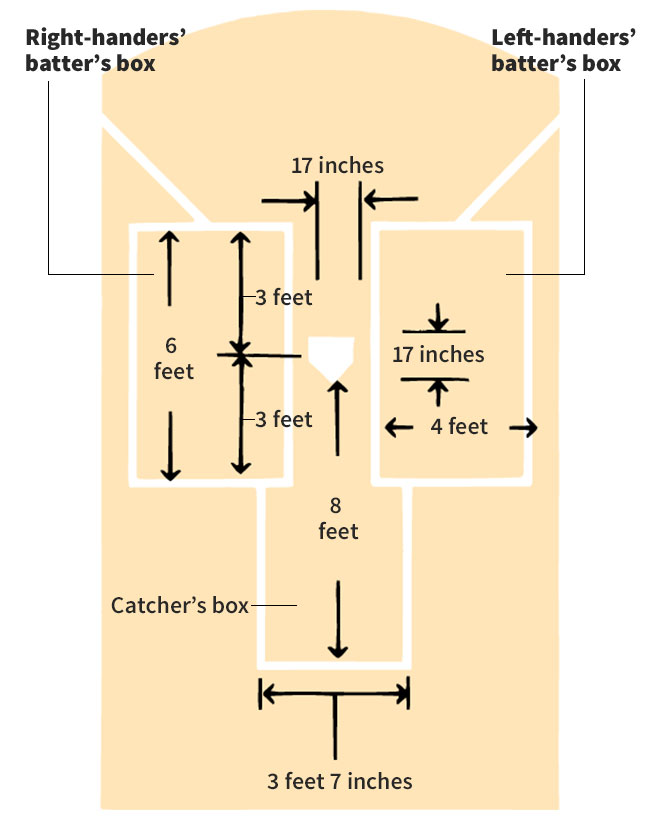
First base, second base, and third base are white canvas bags filled with kapok or some other soft material. Each bag is 18 inches (46 centimeters) square and from 3 to 5 inches (8 to 13 centimeters) thick. Spikes anchor the bags to the ground.
White lines made by chalk, lime, or some other material mark the boundaries of a batter’s box on the left and right sides of home plate. Each box is 6 feet (1.8 meters) long and 4 feet (1.2 meters) wide. A catcher’s box 5 feet (1.5 meters) long and 3 feet 7 inches (1.1 meters) wide lies behind the plate. Technically, the catcher’s box lies in foul territory. But it is usually considered part of the infield.
A straight white line called a foul line extends out from each side of home plate. These lines run past first and third base to the walls or fences at the end of the outfield. Each foul line is 3 inches (8 centimeters) wide.
A pitcher’s mound rises near the center of the infield. The mound measures 18 feet (5.5 meters) in diameter and reaches a height of 10 inches (25 centimeters) at its center. A slab of white rubber called the pitcher’s rubber is sunk into the ground at the center of the mound. The plate measures 24 inches (61 centimeters) by 6 inches (15 centimeters). It lies 60 feet 6 inches (18.4 meters) from home plate.
The outfield
lies between the infield and the walls or fences farthest from home plate. Technically, the outfield begins directly behind first, second, and third base. But people usually think of the area just behind the bases as part of the infield. They consider the grass line the dividing point between the infield and the outfield. The grass line is the part of the field where the dirt beyond the bases ends and grass or artificial turf begins. In fields that have an artificial turf infield, a white line marks the location of the grass line.
The size of the outfield varies from field to field. But a major league rule sets minimum sizes. The rule requires that in ballparks opened before June 1, 1958, the outfield must be big enough so that the distance from home plate to the left and right field walls or fences at the foul lines is at least 250 feet (76.2 meters). The distance for ballparks opened after that date must be at least 325 feet (99.1 meters) down each foul line and at least 400 feet (121.9 meters) in center field.
Foul territory
is the part of the field behind home plate and across the foul lines from the infield and the outfield. There is no standard size for foul territory. But the major league rule book recommends that the distance between home plate and the wall behind it be at least 60 feet (18.3 meters).
Two dugouts–one for each team—are built into the wall in foul territory. One lies behind first base, and the other behind third. Usually, the managers and other team members not required to be on the field sit in the dugouts.
White lines outline two coach’s boxes in foul territory—one near first and one near third. The boxes measure 10 feet by 20 feet (3 by 6.1 meters).
An on-deck circle 5 feet (1.5 meters) in diameter lies between each dugout and home plate. The batter who follows the one at bat awaits a turn at bat in the circle nearest the dugout of the team at bat.
A field also includes a bull pen for each team. These areas have space where substitutes can warm up (practice) before entering the game. In some ballparks, the bull pens lie in foul territory across the foul lines from the outfield. In other parks, they are located beyond the outfield walls or fences.
Player positions.
The pitcher of the team in the field stands on the pitcher’s mound. The pitcher must have one foot in contact with the pitcher’s rubber when throwing the ball. The catcher crouches behind home plate, within the boundaries of the catcher’s box. The catcher makes hand signals that tell the pitcher what kind of pitches to throw and catches balls that pass the batter. The pitcher and catcher are called the team’s battery.
The first baseman and second baseman play between first and second base, and the shortstop and third baseman between second and third. These players, called infielders, try to catch balls hit short distances by batters.

The left fielder, center fielder, and right fielder spread out across the outfield. Called outfielders, these players try to catch balls hit past and over the heads of the infielders.
The batter of the team at bat stands in a batter’s box. Left-handed batters stand in the box to the right of home plate. Right-handers stand in the box to the left of the plate.
A coach of the team at bat stands in each coach’s box. The coaches receive hand signals regarding strategy from the manager. They relay the signals to batters and base runners.
Umpires serve as the officials of baseball games. In most major league games, there are four umpires. One umpire stands near each base.
Baseball skills
Basically, baseball matches the skills of the pitcher against those of the batter. But fielders and base runners also play key roles in the game.
Pitching.
A good pitcher can throw a variety of pitches. The most common pitches are the fast ball, the curve ball, and the slider. A fast ball thrown by a major league pitcher may travel more than 90 miles (145 kilometers) per hour. A curve ball thrown by a right-handed pitcher breaks sharply to the left and downward as it reaches the batter. A left-hander’s curve breaks to the right and downward. A slider looks like a curve ball. However, the slider seems to “slide” rather than break sharply, and it does not move downward. Other pitches include the screwball, which breaks just like—but in the opposite direction from—the curve ball; the sinker, which drops sharply as it reaches the batter; and the knuckle ball, which may break to the left or right, or downward. See Bernoulli’s principle.
Batting.
Many experts believe that a batter’s job of hitting a ball thrown by a major league pitcher is the hardest thing to do in any sport. The ball reaches the batter in a fraction of a second. It may move in any of the ways described above as it reaches home plate. Even so, batters are able to follow the flight of the ball, whip the bat around quickly, and drive the ball sharply into the field. A batter may take a full swing and try to hit the ball as far and hard as possible. Or, a batter may take less than a full swing and try to poke the ball between fielders. This batting strategy is called place hitting.

Fielding.
Good fielders can catch almost any ball hit near them and race far after balls and catch them. They can also throw the ball with great speed and accuracy to put out runners. A single outstanding play by a fielder can win a game for a team.
Base running.
Good base runners can steal bases, and take an extra base (one more base than usual) on batted balls. They can quickly judge when to try to advance and when to stay near the base. A base runner, like a fielder, can win a baseball game with one outstanding play.
The game
Before a baseball game begins, the manager of each team makes a list that shows that team’s line-up and batting order. A line-up tells which player will play each defensive position. A batting order shows the order in which the players will take their turns at bat.
The team on whose field the game is played is called the home team. The other team is the visiting team. The visiting team takes the first turn at bat and the home team players go to their positions in the field. The team’s turn at bat lasts until its players make three outs. Every time a player advances around the bases during the turn at bat, the team is credited with a run. When the visiting team’s turn at bat is over, the home team comes to bat and the visitors take the field.
One turn at bat by each team is called an inning. A regulation baseball game lasts nine innings. The team with the most runs at the end of the game wins. If the two teams have the same number of runs after nine innings, they play extra innings until one of them scores more runs than the other in an inning.
Each player who comes to bat during a baseball game tries to reach base and advance around the bases. The pitcher and other players of the team in the field try to put each batter out. There are many ways in which the players make outs, reach base, and advance around the bases.
Outs by batters.
Most batters make outs in one of three ways—by strikeouts, groundouts, or fly-outs.
Strikeouts.
A batter strikes out by making three strikes during a turn at bat. There are four kinds of strikes—swinging strikes, called strikes, foul strikes, and foul tips.
A batter makes a swinging strike by swinging at a pitch and missing it. A called strike occurs when a batter takes (does not swing at) a pitch and the home plate umpire rules that the pitch was within the strike zone. A pitch within the strike zone is one that passes over any part of home plate in a zone that extends from the midpoint between the shoulders and the belt to just below the batter’s kneecap.
A batter makes a foul strike by hitting a foul ball when there are fewer than two strikes against the batter. Foul balls include all batted balls that: (1) settle in foul territory between home plate and first base or home plate and third base, (2) bounce or roll past first or third in foul territory, or (3) land in foul territory beyond first or third. Usually, a foul ball hit after two strikes does not count as a strike. But if the batter bunts (taps the ball) foul after two strikes, it does count as a strike.
A foul tip occurs when a batter hits a ball directly back to the catcher and the catcher catches the ball on the fly. All foul tips count as strikes, no matter how many strikes the batter already has.
Groundouts.
A batter grounds out after hitting a fair ball that touches the ground by failing to reach first base before a fielder holding the ball touches the base or tags the batter with the ball. Fair balls include all batted balls that: (1) settle in fair territory between home plate and first base or home plate and third base, (2) bounce or roll past first or third in fair territory or hit either base, (3) land in fair territory beyond first or third, or (4) pass over an outfield wall or fence in fair territory. Almost all groundouts result from balls hit to infielders or the pitcher.
Fly-outs.
A batter flies out after hitting a fair ball or foul ball if a fielder catches the ball on the fly. The foul tip, described earlier, is an exception to the fly out rule. Foul tips count as strikes, rather than outs.
Fly-outs hit short distances and high into the air are often called pop-ups. Those hit hard and on a fairly straight line are line-outs.
Other outs.
There are several less common ways in which batters can make outs. For example, batters are out if they hit a fair ball and run into the ball, or if they bat out of turn and the opposing manager points out this violation to the home plate umpire.
Reaching base.
Most batters reach base through base hits. A batter makes a base hit by (1) hitting a fair ball that is not caught on the fly, and (2) reaching first base before a fielder holding the ball touches the base or tags the batter with the ball. A batter who makes a base hit may continue to run around the bases. But if a fielder tags the batter with the ball while the batter is off base, the batter is out.
A base hit that enables a batter to reach first base is called a single. One on which a batter reaches second base is a double, third base a triple, and home plate a home run. Most singles result from balls hit into the infield or past the infielders but in front of the outfielders. Most doubles and triples are made on hits that get past outfielders. Almost all home runs result from batted balls hit over an outfield wall or fence. A batter who makes such a hit can simply trot around the bases, and cannot be tagged out.
A batter who hits a ball and reaches base because of a fielder’s mistake is credited with a hit on error, rather than a base hit. One who reaches base because the fielders tried to put a base runner out is credited with a fielder’s choice.
Batters can also reach base without hitting the ball. The most common way is to receive a walk, or base on balls. A batter walks if the pitcher throws four balls (pitches outside the strike zone) during that batter’s turn at bat. A batter who walks goes to first base. A batter also goes to first base if the pitcher hits that batter with the ball. In addition, a batter goes to first on catcher interference. Catcher interference occurs when the catcher touches the bat when a batter is swinging.
Base runners
—advancing and outs. A batter who reaches base becomes a base runner. Base runners try to advance around the bases and score runs for their team. The defensive players try to put the base runners out.
Base runners may try to advance at any time. But they usually wait until the batter hits the ball, and then decide whether or not to try to advance. If there are no outs or one out and a batter hits a ball that is likely to be caught on the fly, base runners stay near their bases. They do so because they must tag up (touch their bases) after a fly out. If a runner fails to tag up before a fielder holding the ball touches the runner’s base or tags the runner with the ball, the runner is out. After tagging up, a runner can try to advance to the next base. The runner must reach the base before being tagged with the ball by a fielder, or else the runner is out.
When there are two outs, runners usually try to advance as soon as a fly ball is hit. They do so because their team’s turn at bat ends as soon as a fielder catches the ball.
Base runners do not have to tag up if a batter hits a ball that touches the ground. But depending on the situation, runners may stay near their bases or run toward the next base on a ground ball. They stay near their bases if they judge that they will not be able to reach the next base before being tagged with the ball. This situation usually occurs on ground balls hit sharply to infielders. If runners believe they can get to the next base before being tagged, they run toward the base. They are out if they fail, and safe if they succeed.
In some situations—called force situations—base runners must try to advance to the next base. A force situation occurs when a batter hits a ground ball and a runner occupies a base another player is entitled to. A batter who hits a ground ball is always entitled to first base. As a result, a runner on first is forced to advance on a ground ball. If a team has runners on first and second base—or on first, second, and third base—all the runners are forced to advance on ground balls. In such cases, each runner forces the runner on the next base. The runners make a force-out if they fail to reach the next base before a fielder with the ball touches the base. The fielder does not have to tag the runner in order to put the runner out.
Sometimes, base runners run with the pitch. That is, they race toward the next base as soon as the pitcher throws the ball. This strategy has both advantages and disadvantages. If the batter takes the pitch, and the runner gets to the next base before being tagged with the ball by a fielder, the runner is safe at the base. This play is called a stolen base. But if the runner fails to reach the base before being tagged, the runner is out. A runner who runs with the pitch can often advance farther on a hit than one who waits until the batter hits the ball. However, the runner risks being put out on a fly ball. Such a runner may end up so far from the base that it is impossible to get back to tag up before a fielder holding the ball touches the base.
Base runners can make outs and advance in other ways than those already described. For example, a runner is out if hit by a batted ball while in fair territory and not on a base. A runner on first base advances to second if the batter walks or is hit by a pitch. If the team also has a runner on second—or runners on second or third—those runners also move to the next base.
Umpires.
Most major league games have four umpires. They are the home plate umpire, first base umpire, second base umpire, and third base umpire. The home plate umpire has the most important job. Every time a batter takes a pitch, the home plate umpire must decide whether the pitch was a ball or a strike. This umpire also decides whether runners trying to reach home plate are safe or out. The first base umpire rules on plays at first base, the second base umpire on plays at second, and the third base umpire on plays at third. The first base and third base umpires also decide whether balls hit down the foul lines are fair or foul.
Baseball leagues
Many people play baseball on an informal basis. They get together with their friends, choose up sides, and play a ball game. But millions of people also play on a formal, organized basis. They join teams that belong to a league. The teams play regularly scheduled games against other teams in their league. The team with the best record at the end of the schedule, or the team that wins a playoff, becomes the league champion.
Baseball leagues range from those for players as young as 6 years old to leagues for adults. The adult leagues include the major leagues and the minor leagues. These leagues are professional leagues. Almost all other leagues are amateur leagues.
Major league and minor league teams consist entirely of men. Almost all players on most amateur teams are boys or men. But in the 1970’s, many girls began demanding the right to play on boys’ teams. Some teams now allow girls to join their teams.
Major leagues
There are two major baseball leagues, the American League and the National League. Each league consists of 15 teams. The teams in each league are divided into three divisions—East, Central, and West. Of the 30 teams that play in the major leagues, 29 are in the United States. The other team is in Toronto, Canada.
Regular season.
Every major league team plays 162 games during the regular season. The major league season starts in late March or early April and ends in late September or early October. During the regular season, each major league team plays all the other teams in both leagues. Teams play half their games at home and half on the fields of their opponents. The team that finishes with the best record in each division wins that division championship.
Playoffs.

World Series.
The American and National League pennant winners meet in the World Series. The first team to win four series games wins the world championship. The World Series is one of the world’s major sports events. Played every year since 1903—except in 1904 and 1994—it captures the interest of millions of people. Many people who have only a small interest in baseball follow the series. TV and radio stations send play-by-play coverage of the series throughout the United States and to many other countries. 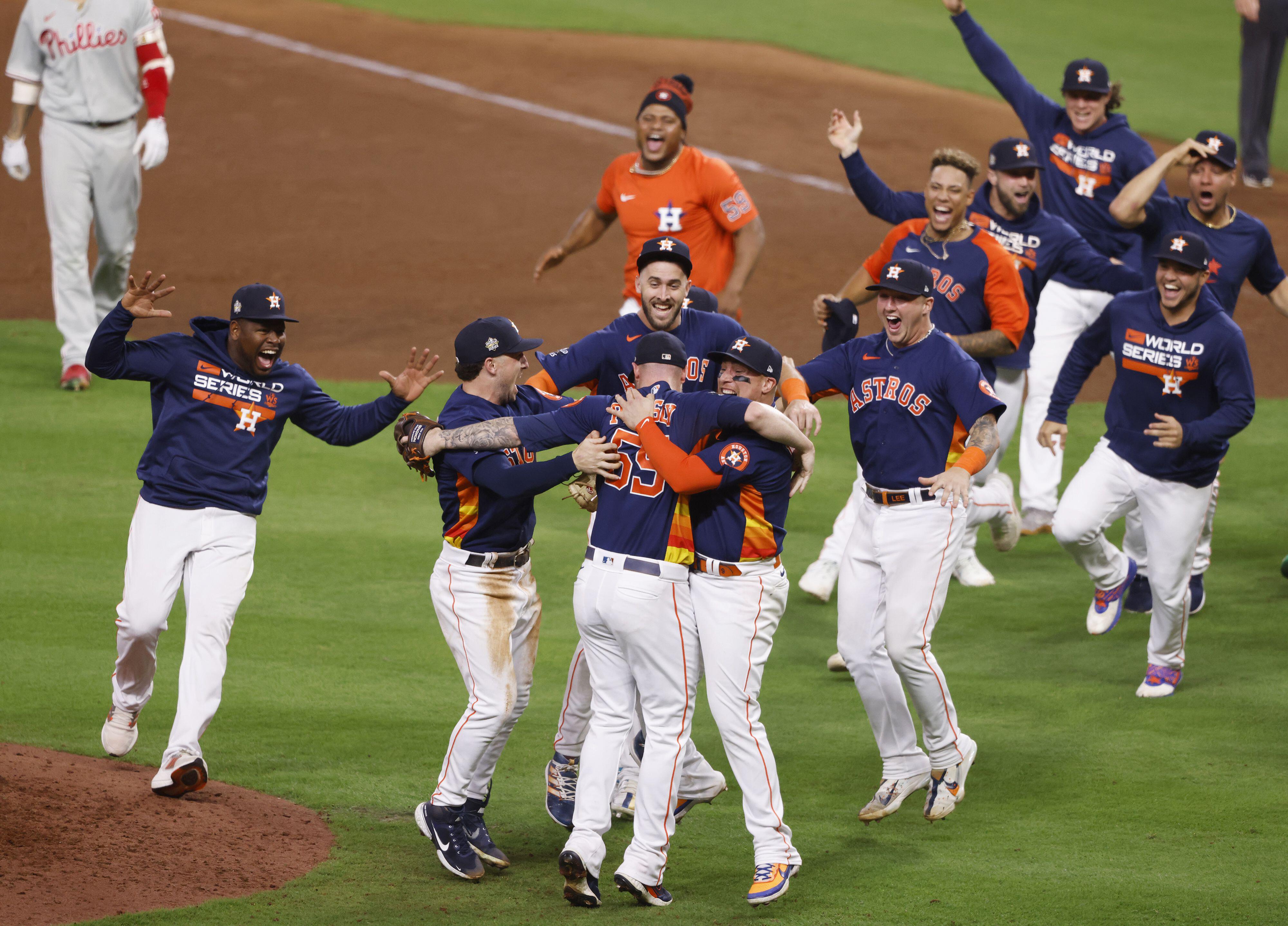
All-Star Game
is a special game played during the regular season. It matches outstanding American League players against star players of the National League. Baseball fans choose the starting line-ups—except the pitchers—for the two teams. The managers of the teams select the starting pitchers and all substitutes.
Minor leagues
Minor leagues serve as training grounds for major league baseball players. Most minor league teams are owned by, or have a working agreement with, a major league team. Under a working agreement, the major league team helps support the minor league team, usually by paying that team’s salaries. In return, the minor league team trains players for the major league team.
There are 14 minor leagues with a total of about 200 teams. The classifications—from the highest to the lowest—are Triple-A, Double-A, High-A, Low-A, and Rookie. Most players start their career in either a Rookie or Low-A league. As they improve, they move to a higher league, and some eventually reach the major leagues. Most minor league teams play in the United States. A few play in southern Canada. Mexico also has a league. Each year, the major leagues hold a draft to select new players. The teams select players primarily from high school and college teams. The new players are normally assigned to a minor league team to gain experience.
In addition to the Triple-A, Double-A, High-A, Low-A, and Rookie leagues, a number of independent minor leagues operate throughout the United States and Canada. Teams in these leagues have no working agreements with major league teams. Independent leagues experienced rapid growth during the 1990’s and early 2000’s as teams built modern new ballparks in areas not previously served by minor league baseball.
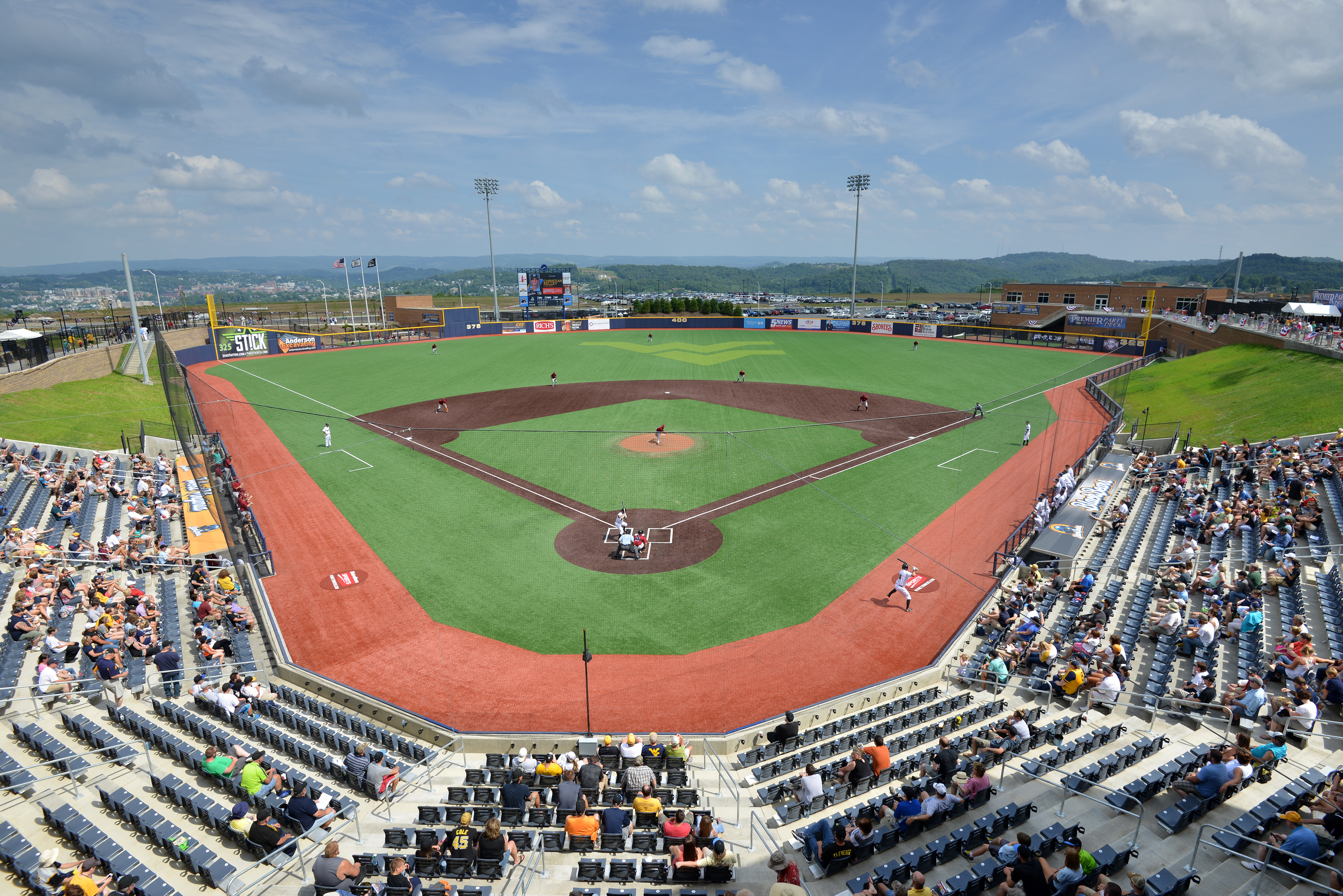
Amateur leagues

Teenagers also play amateur baseball in American Legion leagues and Babe Ruth leagues. Most high schools and colleges have baseball teams that belong to a league. The National Baseball Congress sponsors amateur leagues for adults.
Most amateur baseball leagues follow the same rules as the major leagues, but some have special rules. For example, the teams of leagues for young players play on fields that are smaller than those of the major leagues. Also, the games of these teams may be scheduled for fewer than nine innings. Some leagues allow players to use aluminum bats to hold down the cost of equipment. Wooden bats sometimes break when a batter hits the ball, but aluminum bats do not. High school leagues allow starting players to leave and return to the game once. This rule enables more players to participate.
Baseball around the world
Baseball has become popular in a number of countries outside the United States and Canada. It is especially strong in Latin America and Japan. Many of the biggest stars in American major league baseball have come from Puerto Rico, Venezuela, and such Caribbean countries as Cuba and the Dominican Republic. Baseball is one of the most popular sports in Mexico, exceeded only by soccer. Many Mexicans play on baseball teams in amateur leagues, and Mexico also has professional baseball leagues.
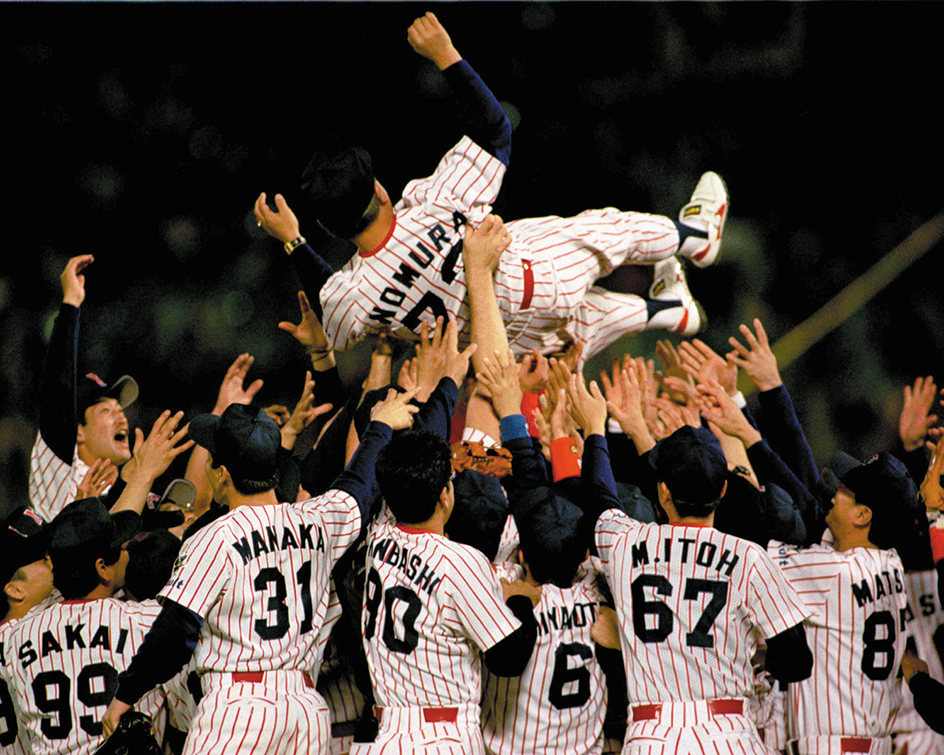
Baseball has also spread to some European countries. In 1953, European countries formed the European Baseball Federation to organize the European Baseball Championship. Nine countries take part—Belgium, France, Germany, Italy, the Netherlands, Poland, Spain, Sweden, and the United Kingdom.
Baseball is widely played in Australia. Visiting American miners introduced baseball to Australia in 1873. Five states began competing for the Claxton Shield in 1934. The game increased in popularity after it changed from a winter sport to a summer sport in 1965. Australia became a member of the Baseball Federation of Asia in 1970.
Baseball was a medal sport in the Summer Olympic Games from 1992 through 2008. It also was an Olympic event in the 2020 games. In 2023, the International Olympic Committee added baseball to the 2028 Summer Olympic Games, which are scheduled to be held in Los Angeles.
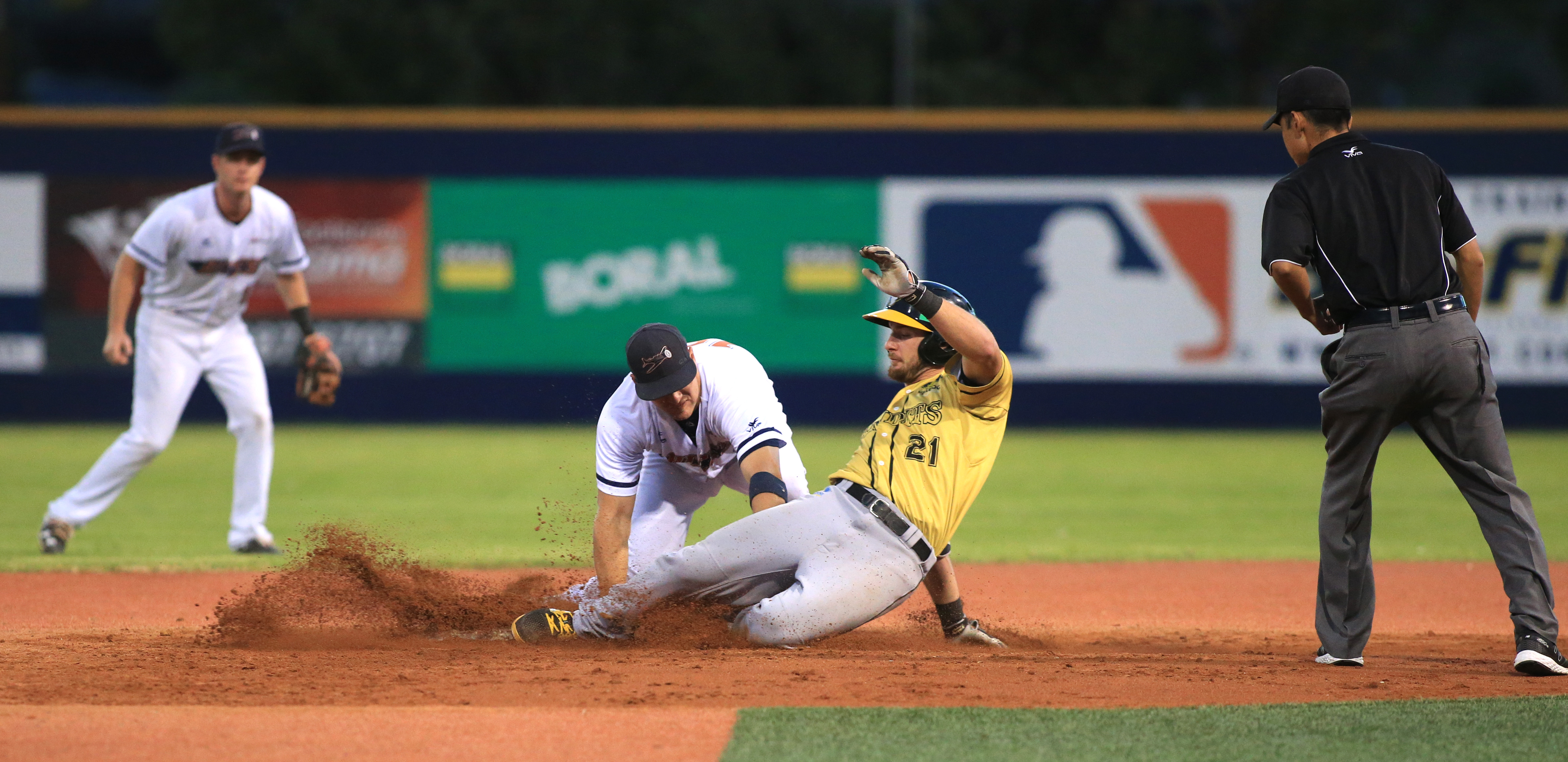
History
Baseball began in the United States in the mid-1800’s. Historical evidence indicates that Americans developed the game from an old English sport called rounders. In spite of this evidence, many people believe that Abner Doubleday of the United States invented baseball.
Early development
Rounders.
People in England played rounders as early as the 1600’s. Rounders, like baseball, involved hitting a ball with a bat and advancing around bases. Although rounders resembled baseball, there were many differences between the two games. Perhaps the main difference was the way in which fielders put out base runners. Fielders threw the ball at runners. If the ball hit a runner who was off base, the runner was out. This practice was called soaking or plugging runners.
From rounders to baseball.
American colonists in New England played rounders as early as the 1700’s. They called the game by several names, including town ball, the Massachusetts game, and—sometimes—base ball. Rules for the game appeared in books from time to time. Even so, people generally played the game according to their local customs. The number of players on a side, the number of bases and distance between them, and other rules varied from place to place.
Americans gradually changed the game into baseball. The earliest known published reference to organized baseball appeared in the July 13, 1825, edition of the Delhi (New York) Gazette.
One of the key points in the development of baseball took place when players replaced the practice of soaking runners with the present practice of tagging them. Historians believe players in New York City probably made the change in the 1830’s or 1840’s.
The Abner Doubleday Theory.
In spite of evidence showing that baseball developed from rounders, many people believe that Abner Doubleday invented the game in Cooperstown, New York, in 1839. Doubleday later became a general in the U.S. Army. He died in 1893.
The Doubleday Theory arose from a dispute over the origin of baseball in the early 1900’s. A commission was appointed to settle the question of the game’s origin. Many people told the commission that baseball developed from rounders. But the commission’s report, published in 1908, credited Doubleday with inventing the game. It based its conclusion on a letter from Abner Graves, who had been a boyhood friend of Doubleday’s. Graves said he had been present when Doubleday invented baseball in Cooperstown in 1839.
Historians now believe that Doubleday had little, if anything, to do with baseball. They also point out that the game described by Graves included the practice of soaking runners. Thus, it was not essentially different from rounders.
Alexander Cartwright,
a New York City sportsman, is called the father of organized baseball. In 1845, he started a club whose only purpose was playing baseball. Called the Knickerbocker Base Ball Club of New York, it was the first organization of its kind. Cartwright wrote a set of baseball rules when he organized the club. These rules, together with rules added in 1848 and 1854, did much to make baseball the game it is today.
The 1845 rules set the distance between the bases at 90 feet (27.4 meters), and provided for nine players on a side. They contain the first known mention of the need to tag runners rather than soaking them. The 1848 addition included the present-day rule of tagging first base to put a batter out on a ground ball. The force out rule was added in 1854.
Rule changes.
Although Cartwright’s rules and today’s rules are alike in many ways, there are also many differences between the two. Following are some of the original rules and the dates when they were changed.
Length of game.
Cartwright provided that the first team to have 21 or more runs at the end of an inning won the game. The present rule in which the team with the most runs after nine innings wins was adopted in 1857.
Pitching.
At first, the pitcher stood 45 feet (13.7 meters) from home plate and had to throw the ball underhanded. The pitching distance was increased to 50 feet (15.2 meters) in 1881 and to the present 60 feet 6 inches (18.4 meters) in 1893. The rule that allows the pitcher to throw overhanded was adopted in 1884.
Fly-outs.
Originally, a batter was out if a fielder caught the ball either on the fly or on the first bounce. An 1864 rule change provided that fair balls caught on the bounce were not outs. An 1883 rule change provided that foul balls caught on the bounce were not outs.
Strikes and balls.
In early baseball, batters only made strikes by swinging and missing. Called strikes became part of the game in 1868. The National League adopted the foul strike rule in 1901, and the American League in 1903. There was no such thing as a walk in early baseball. An 1879 rule change provided that a batter walked after nine balls. The present four-ball rule was introduced in 1889 after several changes.
The spread of the game
Groups throughout the eastern United States formed baseball clubs shortly after the Knickerbocker Club began. The Civil War (1861-1865) helped spread baseball to all parts of the country. Union soldiers who knew about the game often played it for recreation. Other Union troops and Confederate prisoners watched them. In this way, people from many parts of the nation learned baseball. They taught it to others when they returned home after the war. Soon, people in cities and towns and on farms in all parts of the country began playing baseball.
Professional baseball.
All early baseball players were amateurs. But in 1869, the Cincinnati Red Stockings decided to pay all its players and became the first professional baseball team. Many other teams then turned professional. In 1876, eight professional teams formed the National League, the first major league. Eight teams formed the American League in 1900. The American League became the second major league in 1901.
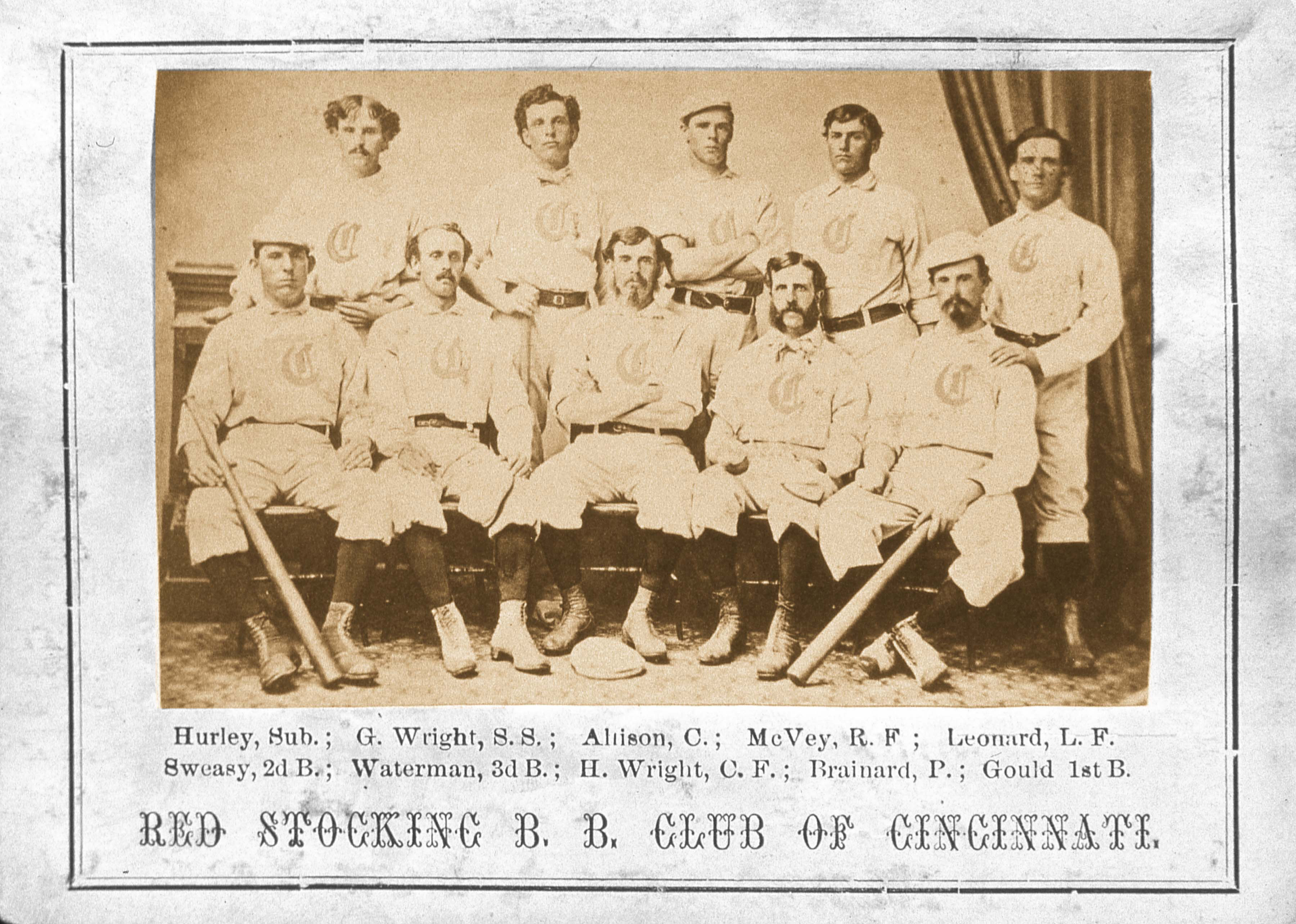
At first, the cities represented by major league teams changed often. By 1900, the National League had teams in Boston, Brooklyn, Chicago, Cincinnati, New York City, Philadelphia, Pittsburgh, and St. Louis. By 1903, the American League teams represented Boston, Chicago, Cleveland, Detroit, New York City, Philadelphia, St. Louis, and Washington, D.C. The same 16 teams were to make up the major leagues and play in the same cities for 50 years.
Early strategy and stars.
Early major league baseball is sometimes called the dead ball era. Baseballs used from the start of the game until about 1920 were “dead”; that is, less lively than those used today. Most batters were place hitters rather than long ball hitters. Wee Willie Keeler, a leading batter of baseball’s early days, stated the batting philosophy of the era. His famous motto was: “I hit ’em where they ain’t.”
Bunting and base stealing were more common in the early days than they are now. But since the early 1960’s, there has been an increase in base stealing. King Kelly probably was the most popular player of the late 1800’s. His fame came from his ability to run the bases. Fans urged him on with the chant, “Slide, Kelly, Slide.”
Other stars of the 1800’s included Cap Anson and Charlie (Old Hoss) Radbourn. Anson became the first player to make more than 3,000 base hits during a career. Radbourn pitched 73 complete games in 1884 and won 59 of them.
The 1900’s
Loading the player...
World Series 1948
Interest in baseball soared after 1900. The game soon played such an important part in American life that it became known as the national pastime. Many boys spent almost all their leisure time during warm weather playing baseball. People in all walks of life eagerly followed the major league pennant races and the World Series. Star players became local, or even national, heroes. Many people could name every major league player, and knew the batting averages and other accomplishments of players. Jacques Barzun, a famous philosopher and educator, perhaps best summed up the importance of baseball in American life. Barzun wrote: “Whoever wants to know the heart and mind of America had better learn baseball.”
The early 1900’s.
The year 1900 marks the beginning of the modern era of major league baseball. By that time, the two major leagues had been formed, and most baseball rules were the same as today. Records established by players and teams are divided into two categories: modern (since 1900) and premodern (before 1900). Career records made by players who played during both periods are counted as modern records. For example, Cy Young holds the modern record for most games won by a pitcher (511). But Young won about half of these games before, and half after, 1900.

The Black Sox Scandal.
In 1919, the Cincinnati Reds defeated the Chicago White Sox in the World Series. The next year, eight White Sox players were accused of throwing (trying to lose) the World Series in return for money from gamblers. Baseball Commissioner Kenesaw Mountain Landis banned the eight players from baseball. This scandal, called the Black Sox Scandal, shocked fans and hurt the game’s reputation. Landis had been appointed commissioner in 1920 especially to investigate the scandal. A federal judge with a reputation for honesty, he helped restore public confidence in baseball.
The Babe Ruth Era.
Also in 1920, Babe Ruth joined the New York Yankees. Around that time, teams began using livelier baseballs. Ruth began hitting more and longer home runs than anyone thought possible. He hit more than 50 homers in four different seasons, including a record 60 home runs in 1927. Before Ruth, no player had hit more than 24 in a season. Ruth had hit 714 home runs when he retired in 1935.

Ruth’s fame became so great that the 1920’s in baseball is often called the Babe Ruth Era. Wherever the Yankees played, fans flocked to see Ruth. Large numbers of people who knew nothing about baseball began following Ruth’s career and became interested in the game. In addition, Ruth’s success helped change baseball strategies. More batters became full swingers rather than place hitters, and home runs became a leading part of the game.
Baseball’s many other stars of the Babe Ruth Era included first baseman Lou Gehrig. Gehrig became the first modern player to hit four home runs in a game. He also played in 2,130 consecutive games, a major league record until Cal Ripken, Jr., broke it in 1995. Rogers Hornsby reached his peak during the era. In 1924, he hit .424 for the St. Louis Cardinals, a modern National League record.
Many radio stations began broadcasting baseball games during the 1920’s. As a result, play-by-play accounts of baseball games reached millions of people.
Depression and war.
Major league baseball, like other businesses, faced economic hardship during the Great Depression of the 1930’s. Money received from radio stations in return for the right to broadcast games helped teams financially. Also, some team owners installed lights in ballparks so that teams could play at night and attract fans who worked during the day. The first night game took place in Crosley Field, Cincinnati, between the Cincinnati Reds and Philadelphia Phillies on May 24, 1935. The first All-Star Game was played in Comiskey Park in Chicago on July 6, 1933. The Baseball Hall of Fame opened in Cooperstown in 1939.

The United States entered World War II in 1941. Many major league players served in the armed forces. From 1942 through 1945, teams used many players who were too old, too young, or physically unable to serve in the armed forces. The war ended in 1945, and most of the players returned to baseball for the 1946 season.
During the war, the All-American Girls Professional Baseball League was formed, with teams in several small Midwestern cities. Play began in 1943 and ended after the 1954 season.

The many stars who played both before and after the war included Joe DiMaggio, Ted Williams, Stan Musial, and Bob Feller. DiMaggio, a Yankee outfielder, became one of the game’s greatest all-around players. He set a record when he made one or more base hits in 56 consecutive games in 1941. Williams, a Boston Red Sox outfielder, ranks among baseball’s all-time great hitters. He had a lifetime batting average of .344. In 1941, Williams batted .406, marking the last time anyone hit over .400 in the American League. Musial starred as a first baseman and outfielder for the Cardinals. He won seven National League batting titles. Feller, a pitcher for Cleveland, won fame for his blazing fast ball and many strikeouts.
Postwar baseball.
Attendance at baseball games soared after World War II. In the late 1940’s and early 1950’s, many teams began televising some games.
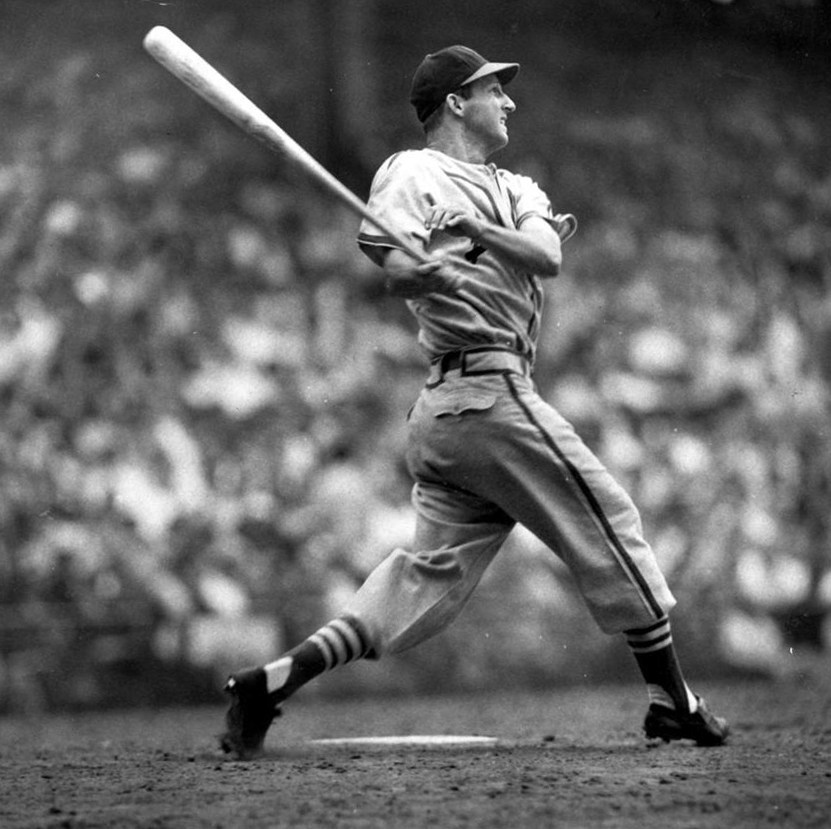
Until the mid-1940’s, Black players were not allowed to play in the white-controlled major leagues. Instead, they played in leagues made up entirely of Black players. These Negro leagues received little publicity. But they had many outstanding players, including Cool Papa Bell, an outfielder; Josh Gibson, a catcher; and Satchel Paige, a pitcher.
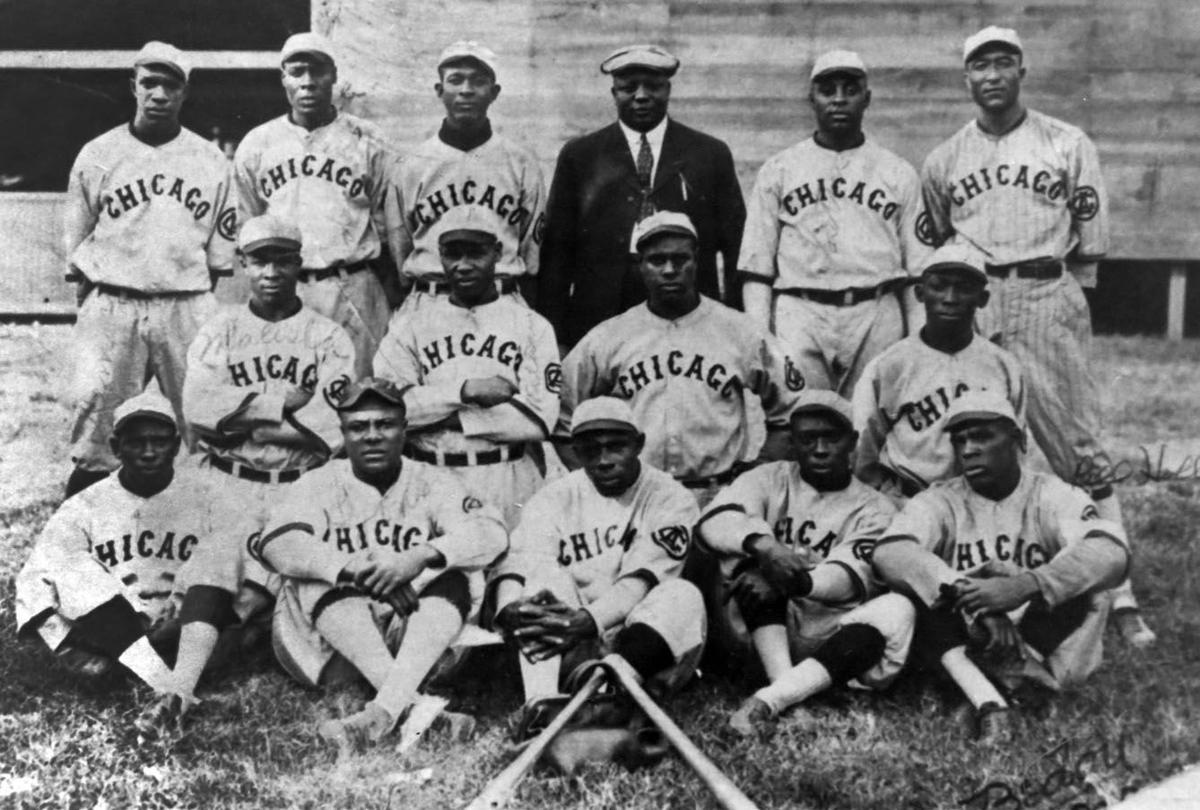

Jackie Robinson became the first Black player in modern white-controlled major league baseball when he joined the Brooklyn (now Los Angeles) Dodgers in 1947. Many other Black players entered the white-controlled major leagues after Robinson.
The Yankees had become baseball’s strongest team during the Babe Ruth Era. From then until the 1960’s, they dominated the game more than any other team before or since. From 1949 through 1953, they established a record by winning five straight pennants and World Series. Casey Stengel was their manager.
Franchise shifts and expansion
brought about important changes in the major leagues. In 1953, the Boston Braves moved to Milwaukee, marking the first time a National League franchise (team) had moved since 1900. In 1954, the St. Louis Browns moved to Baltimore and changed their name to the Orioles, in the first American League shift since 1903. Several other teams later moved to other cities. Also, during the 1960’s, the American and National leagues each added four new teams. In 1969, each league split into two 6-team divisions. In 1977, the American League expanded to 14 teams, which were divided into two 7-team divisions.
The late 1900’s to the early 2000’s.
In 1961, the American League increased the number of games played by each team yearly from 154 to 162. The National League went to 162 games in 1962.
On April 8, 1974, outfielder Hank Aaron of the Milwaukee (now Atlanta) Braves hit his 715th career home run, breaking what was probably baseball’s most glamorous record—Babe Ruth’s career home run total. By the time Aaron retired after the 1976 season, he had hit 755 home runs. On Aug. 7, 2007, Barry Bonds hit his 756th home run, breaking Aaron’s career record. In 1998, Mark McGwire of the St. Louis Cardinals broke Roger Maris’s single season record of 61 homers and ended the season with a record 70 home runs. Barry Bonds broke McGwire’s record by hitting 73 home runs in 2001.

Rickey Henderson, an outfielder for the Oakland Athletics, set a career stolen base record of 1,406 from 1979 to 2003. In 1982, Henderson also set the single season major league record of 130 stolen bases. On Sept. 11, 1985, player-manager Pete Rose of the Cincinnati Reds broke Ty Cobb’s major league record of 4,191 base hits during a career. By the time he retired as a player after the 1986 season, Rose had 4,256 base hits. In 1989, Baseball Commissioner A. Bartlett Giamatti banned Rose from baseball for life on charges that Rose had violated baseball rules by betting on baseball games.

In pitching, Nolan Ryan of the Houston Astros broke his own record for no hit games when he pitched his seventh no hitter in 1991. In 1973, Ryan struck out 383 batters, a major league record for one season. Randy Johnson won the 1995 Cy Young Award as the best pitcher in the American League while playing for the Seattle Mariners. He won the award four consecutive seasons (1999, 2000, 2001, and 2002) while pitching for the Arizona Diamondbacks in the National League.

The two major leagues were each reorganized into three divisions—East, Central, and West—beginning with the 1994 season. The playoffs were expanded to include the division winners plus the second place “wild card” team with the best record in each league.
Conflicts between the union of major league players and the owners of the teams frequently disrupted major league play during the late 1900’s. There were eight strikes or lockouts from 1972 to 1994. The most serious work stoppage occurred in 1994. A strike began August 12 over financial issues and led to cancellation of the playoffs and the World Series. It was only the second time that the World Series was not played. The first time occurred in 1904. The players ended their strike on March 31, 1995.
Recent developments.
In 2004, a controversy developed in major league baseball over the possibility that some players were taking illegal drugs called anabolic steroids to enhance their performance. Anabolic steroids are chemical compounds that enable people to add muscle mass and increase their strength. In 2005, the baseball commissioner and the players’ union announced a system of penalties to be applied to players who test positive for illegal steroid use. In 2006, the commissioner appointed former U.S. Senator George J. Mitchell to lead an investigation into steroid use. In 2007, Mitchell released a report that named nearly 90 current and former players as taking steroids or other performance-enhancing drugs during their major league careers. The players named included outfielder Barry Bonds and pitcher Roger Clemens.
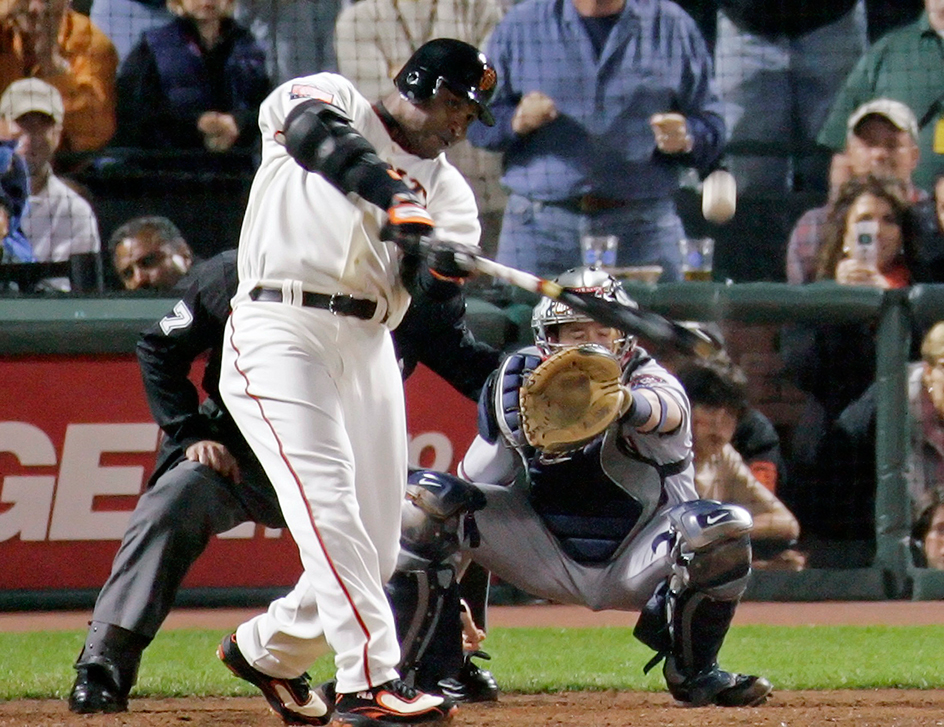
In 2006, the first World Baseball Classic (WBC) was held. The competition now features 20 national teams representing countries from North America, Latin America, Europe, Australia, and Asia. Major league players play for many of the teams. Japan defeated Cuba to win the first championship in 2006. Japan also won the WBC title in 2009 and 2023. The Dominican Republic won the WBC title in 2013, and the United States won the title in 2017.
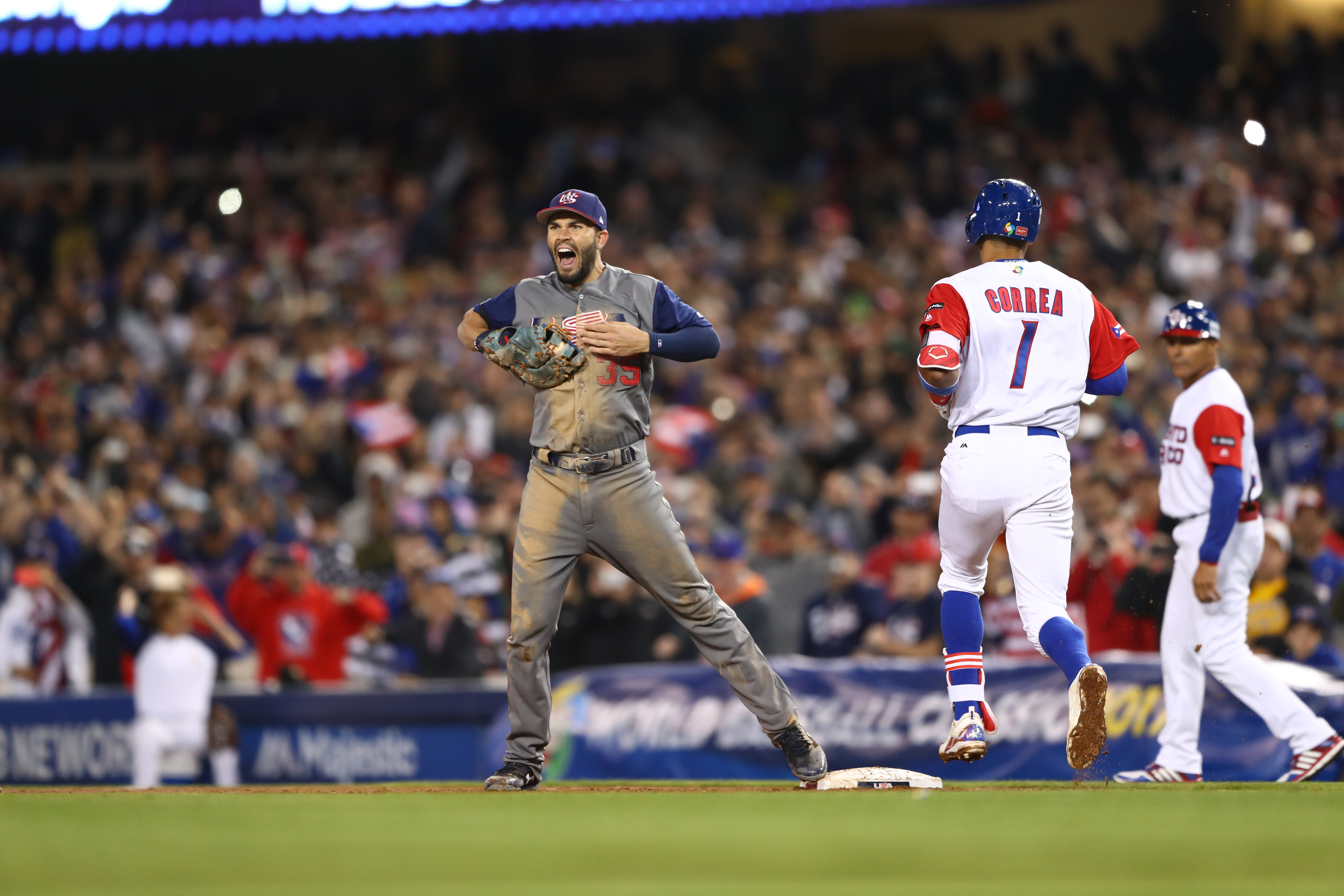
A new generation of baseball stars emerged in the early 2000’s. Perhaps the most publicized was New York Yankee infielder Alex Rodriguez. He led the American League in home runs five times and was named the league’s Most Valuable Player three times. In 2013, major league baseball suspended Rodriguez 211 games (later reduced to 162 games) for violating its policy that bans players from taking performance-enhancing drugs. As a result, Rodriguez missed the entire 2014 season.
In 2004, Ichiro Suzuki, an outfielder from Japan, set a new single-season record for hits with 262, breaking the record of 257 set by George Sisler of the St. Louis Browns in 1920. Infielder Miguel Cabrera of the Detroit Tigers led the American League in batting average in 2011, 2012, and 2013. In 2012, Cabrera won the Triple Crown of batting, leading the league in batting average, home runs, and runs batted in. Cabrera became the first major league player to win the Triple Crown since 1967. Cabrera was named the American League Most Valuable Player in 2012 and 2013. 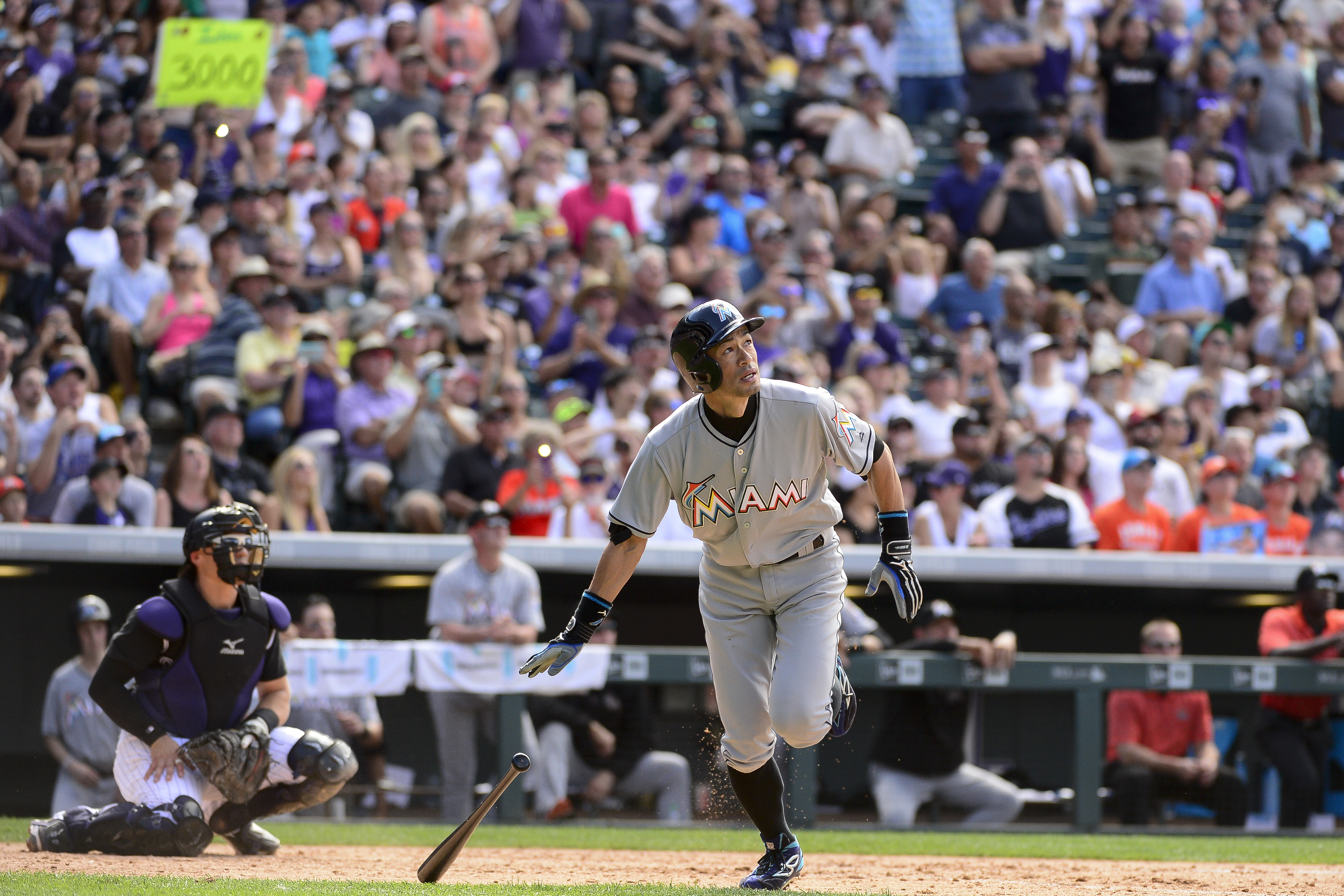
Outfielder Mike Trout of the Los Angeles Angels of Anaheim entered the American League as a 19-year-old rookie in 2011 and soon created a sensation with his speed and range as a fielder and his hitting for both a high average and for power. Trout was the league Rookie of the Year in 2012 and its Most Valuable Player in 2014, 2016, and 2019.
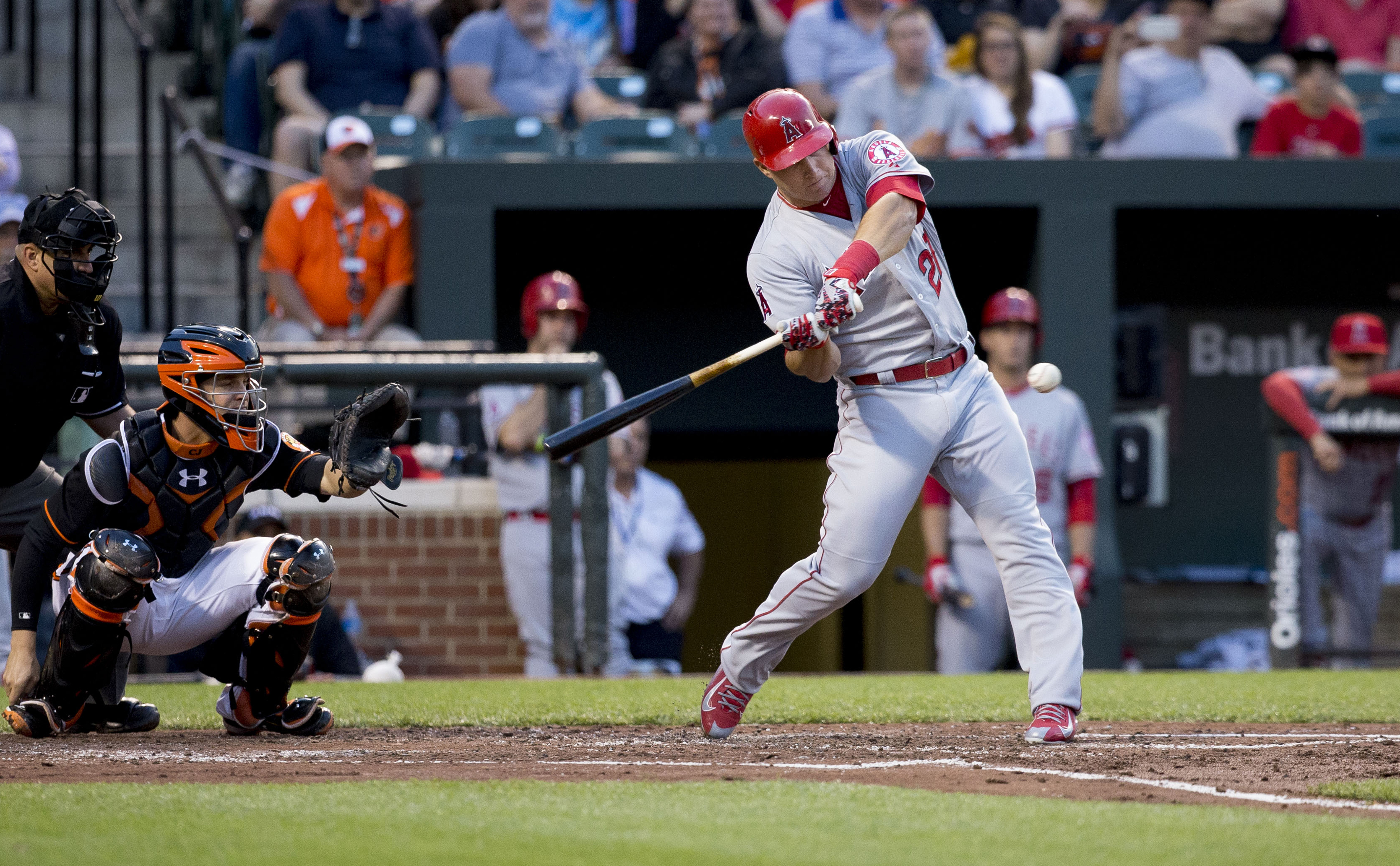
The leading pitcher of the early 2000’s was Clayton Kershaw of the Los Angeles Dodgers. Kershaw won the National League Cy Young Award in 2011, 2013, and 2014. In 2014, Kershaw was also selected as the National League’s Most Valuable Player, a rare honor for a pitcher.
In 2012, a second wild card team was added to the playoffs in each league. A third wild card team was added in each league in 2022. Six teams from each league now qualify for the playoffs—the three division winners and the three wild card teams. The six qualifying teams in each league play a sequence of three playoff rounds to determine which team wins the league pennant. The two pennant winners move on to play each other in the best-of-seven-games World Series.
A major scandal rocked baseball in 2020, when an MLB investigation revealed that the Houston Astros had used technology to steal signs from opposing catchers. The team had made use of a camera feed that was part of their home stadium’s instant replay system to view and decode the hand signals used by catchers to call for particular pitches. This information was relayed to players in the dugout and on the field, telling batters which pitches to expect. The period of cheating included the team’s 2017 championship season. The league fined the Astros and stripped them of first round draft picks in 2020 and 2021. MLB also suspended the Astros’ manager, A. J. Hinch, and the team’s general manager, Jeff Luhnow, who were later fired. However, Baseball Commissioner Rob Manfred rejected calls to punish players or strip the team of its 2017 championship.
Also in 2020, MLB suspended spring training and postponed the regular season because of the COVID-19 pandemic. COVID-19 is a contagious respiratory disease. In June, MLB announced that a shortened, 60-game regular season was scheduled for 2020. The season began in July. Special precautions were put in place to protect players and others and to limit the spread of COVID-19. For example, games were played between regional opponents to limit travel. Also in June, for the first time since minor league baseball began in 1901, officials canceled the 2020 minor league season because of COVID-19.
In 2020, MLB raised the Negro leagues to major league status. In 2024, after reviewing the statistics and records of thousands of players who played in the Negro leagues from 1920 to 1948, MLB began incorporating them into major league historical records.

